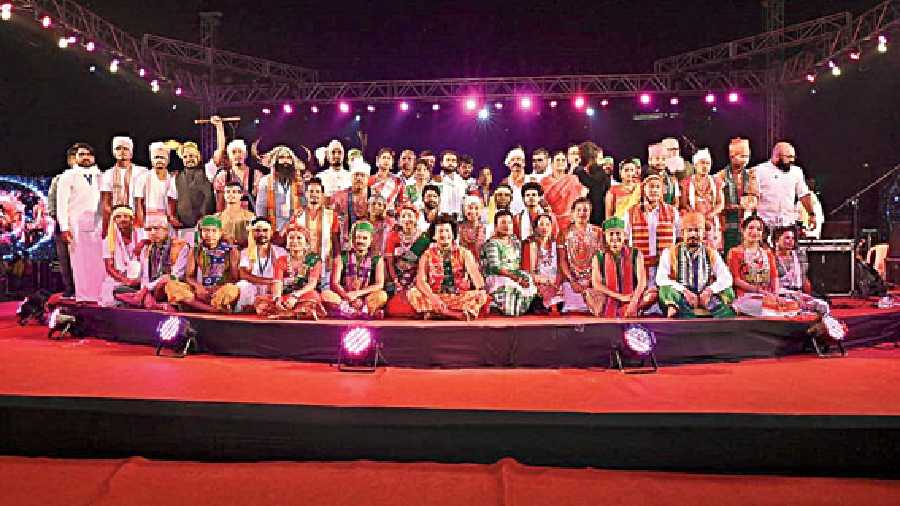Arshad Hussain Lone of the Dardsheel tribe hails from Gurez in Kashmir. He runs Shakoor Foundation, which is involved in community development projects in his native place.
Maya Soren of the Santhal tribe in Jharkhand is a home chef who besides being an expert in local cuisine, loves to learn and experiment with cuisines of other tribes.
Manuel Siddhi of the Siddhi community in Karnataka is proud of his African heritage and is eager to learn about other tribal cultures so that he can share the knowledge with his own people.
Bhagyashree is a young tribal Sarpanch from a remote village in Maharashtra’s eastern fringes. As a village leader, she works towards eradicating problems related to lack of education, health and income opportunities in her area.

The synchronous beats of 501 nagadas (indigenous drums) played by tribals from different parts of India reverberated in homage to Dharti Aaba (Birsa Munda, the champion of Adivasi struggles) to announce the inauguration of Samvaad 2022, at Gopal Maidan in Jamshedpur
These men and women were among the thousands who came together at Samvaad 2022, a five-day tribal conference in Jamshedpur that was inaugurated on Jharkhand Day (November 15), which also commemorates the birth anniversary of tribal leader Birsa Munda. Enabled by Tata Steel Foundation, it brought together 2,500 people representing 150 Indian tribes including 27 Particularly Vulnerable Tribal Groups (PVTGs) and was perhaps the biggest ever platform on tribalism in India. Tribes from Brazil, Mexico, Laos, Zambia and Uganda were also present. Hosted as an annual event since 2014, Samvaad has now emerged as an ecosystem that, besides upholding and celebrating the richness of each unique tribal identity, seeks to promote constructive dialogue and discussion among diverse ethnic communities to drive positive changes in their lives.
Discussions were conducted every day in ‘Akhra’ sessions that were participated by no less than 500 tribals from all parts of the country and beyond. They ranged from dialogues on common socioeconomic problems faced by tribals, problems related to education and healthcare, basic questions of identity, heritage, voice, exclusion from social mainstream, and also about their concerns for the future. The conversations also revolved around the discovery of shared aims among the diverse groups and also with the mainstream and thus attempt to co-create common means of attaining them.
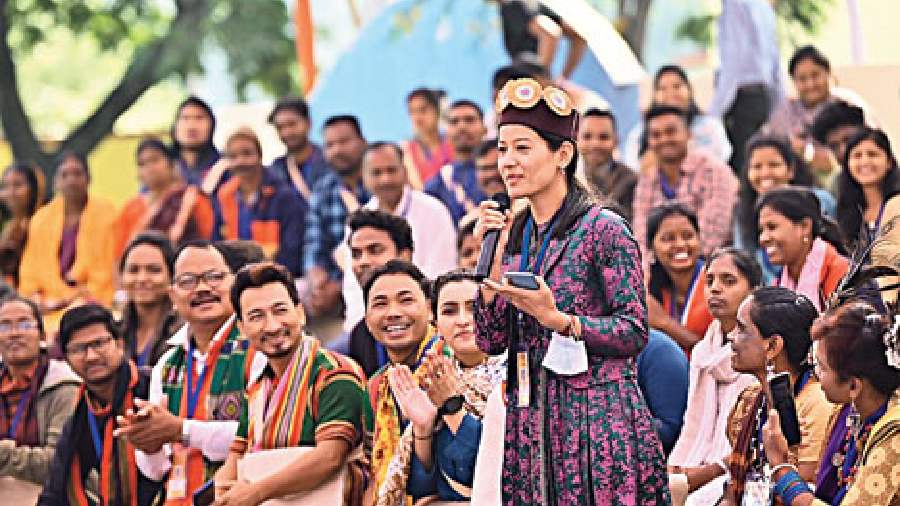
The interactive Akhra sessions hosted at the Tribal Culture Centre every morning were full of fun moments. They were also a melting pot of ideas and inspiration as tribals were encouraged to share stories on their lives on how they had beaten odds to bring about positive change
‘Reimagine’, this year’s theme for Samvaad, was explained by Tata Steel Foundation CEO Sourav Roy. He said that the time has come for the mainstream to review and re-evaluate conventional, established ways of life. It is also necessary, in view of shifting global paradigms, to contemplate new ways of doing things, or learn to adopt techniques of living from those communities who have been more successful in dealing with crisis. It was recommended that tribals and mainstreams must together play their individual and collective roles to develop a symbiotic model for sustainable growth.
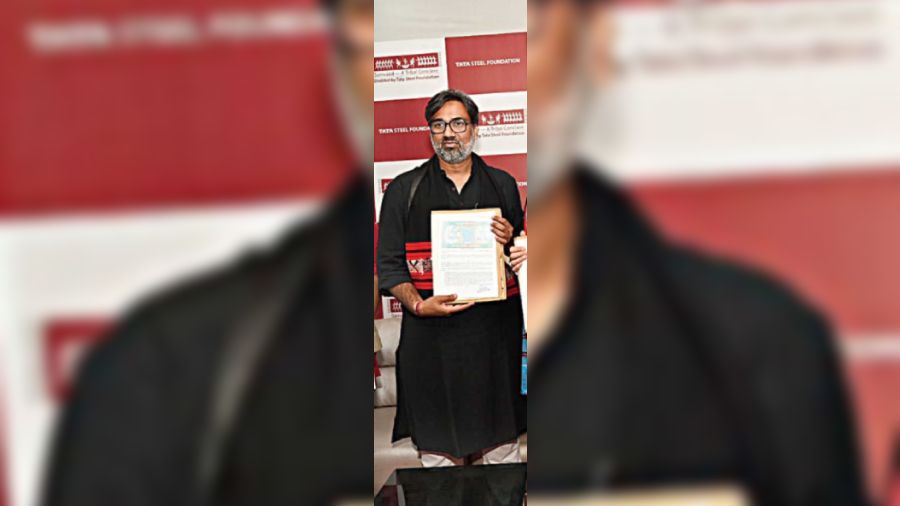
Tata Steel Foundation CEO, Sourav Roy
Thus, one of the key concepts that evolved as an outcome of discussions was about the richness of tribal knowledge and resources and their importance and relevance for a safer, sustainable and more futureready planet. Over 175 tribal healers at Samvaad, who had converged to share their skills, experience and wisdom, were perhaps one of the most powerful validations of this idea. Dr Basavi Kiro of the Urao tribe in Jharkhand, who has been practising horopathy and ethnomedicine since the last 15 years, cited traditional methods of diagnosis and healing of diseases like malaria, anaemia, diabetes, kidney stones, gynaecological problems and others that have gained recognition in many tribal communities of the country. Though it has now been proven that ethno-medicine is the origin of all modern medicine, she is aware of the suspicion towards alternative medicine in the modern world, and is presently trying to get medicinal plants and the medicine obtained from them tested in government labs. This will enable the inclusion of 5,000-year-old Santhal medicines in the mainstream and be part of the government’s initiatives on Ayush as well.

Dr Basavi Kiro
Annet Nangendo, vice-chairperson of Uganda National Integrated Forum for Traditional Health Practitioners, affirmed that traditional medicine has gained legal acceptance in her country already. Covid-19 was treated successfully with the help of tribal medicine and resulted in less casualties for that country from the disease. Life-threatening diseases like cancer and HIV-AIDS are also being well managed and life-span is being prolonged, with the help of tribal medicines.
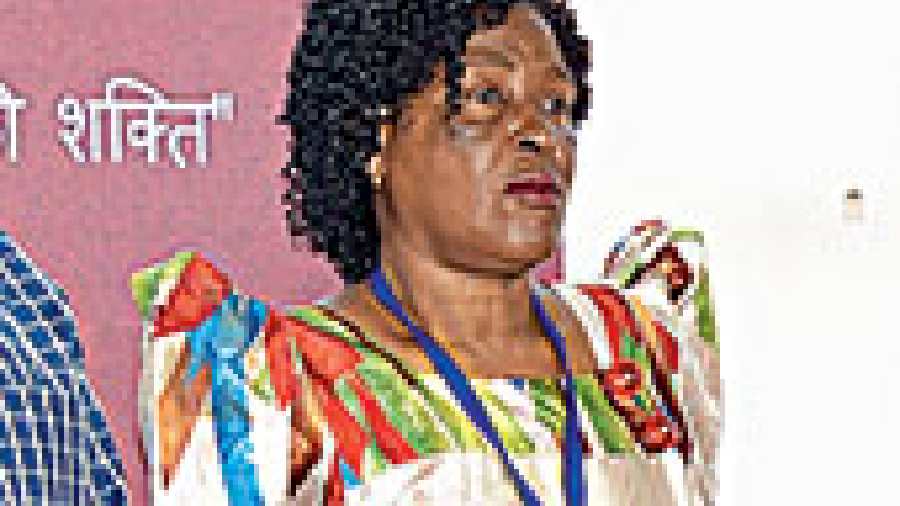
Annet Nangendo
Another key takeaway from the Akhra dialogues was that indegenous people should be at the forefront of discussions and policies on conservation of environment. Bacchubhai Dedun of the Bhaili tribe of Aravalli district in Gujarat is a case in point. A crusader for water conservation, his persistent efforts have made the government build dams and implement rainwater harvesting in his village and surrounding areas. Fighting against odds, he convinced the local administration to dig troughs which later became lakes after they got filled with rainwater. His initiative was no less than a revolution in his village and had long-standing benefits for people of the whole region. Dams and lakes helped the water table rise, enabled ease of irrigation, better farming, more livestock, that led to more crops and dairy products, which in turn generated more employment opportunities for the local people, who would previously have to leave their own village and sell their labour cheap in far off places. Good income opportunities for the locals also led to a better quality of life for them. Dedun also has plans to start organic farming in his village soon.
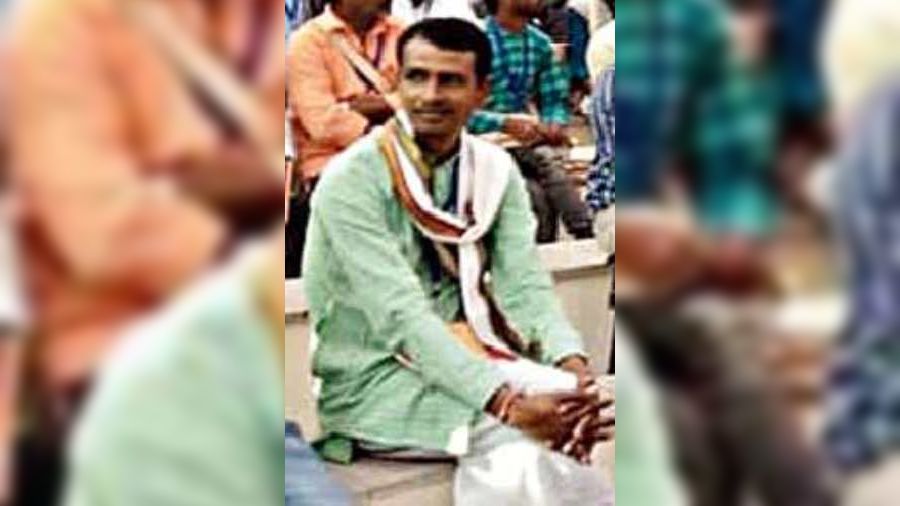
Bacchubhai Dedun
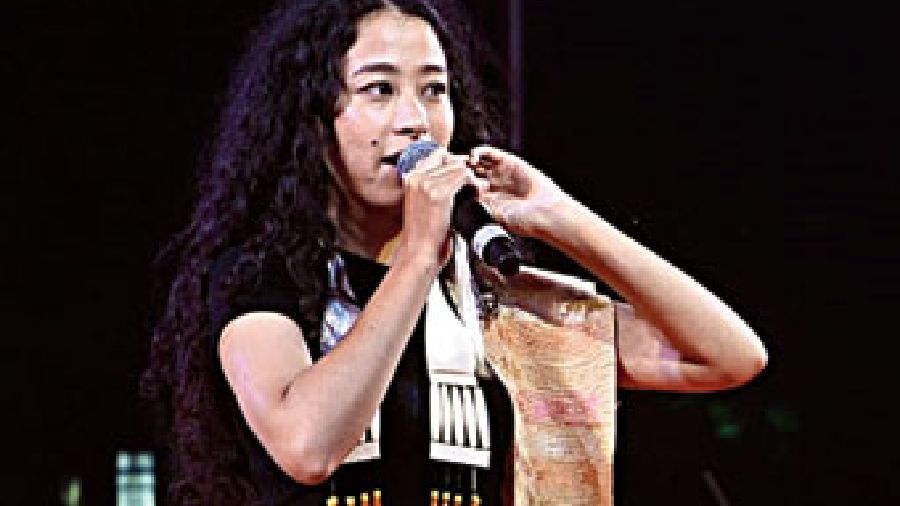
A performance by Purple Fusion band, a tribal music group from North-east India
sAlthough aware of the health benefits to people who will consume its produce, environment concerns are his primary driving force as he knows that chemical-based fertilisers are harmful for the soil and the environment.
The discourse at Samvaad brought to the fore the relevance of a national collective of knowledge and practices for optimal development of all spheres of life, not just for the indigenous community but for all sections of society. The conclave, besides serving as a ready customer base for tribal products and practices, helped build trust and enabled cross-learning among members of different tribes.
Samvaad also became a means for conserving tribal heritage with the help of digital mediums. Nine tribal languages got their first ever font and dictionary. Tribal language learning programmes were initiated, seminal mainstream publications were translated to tribal languages and tribal literature translated into mainstream languages.
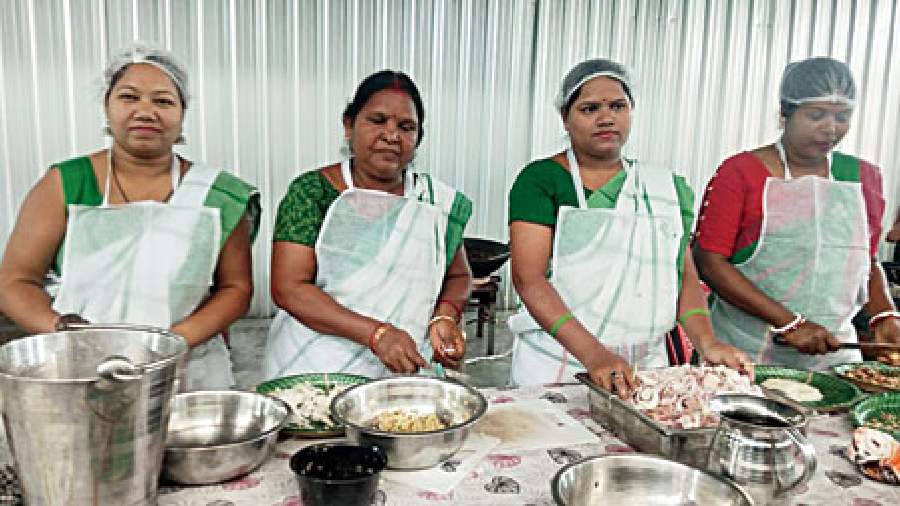
These Santhal home chefs from Jharkhand, who are regular participants at Samvaad over the last few years, prepared local tribal dishes as well as recipes from other tribes that they have learnt from their interaction with tribals from other parts of the country.
Another ‘tangible benefit’ of the conclave was the creation of collective art forms. Artists from multiple tribes painted in their individual art styles on a single canvas, to give birth to a collective art work of astonishing beauty and power. Music album Rhythms of the Earth, which was released at Samvaad, is a tribal artistes collective collaboration with contemporary rock band Swarathma, offering a lively inclusive music experience.
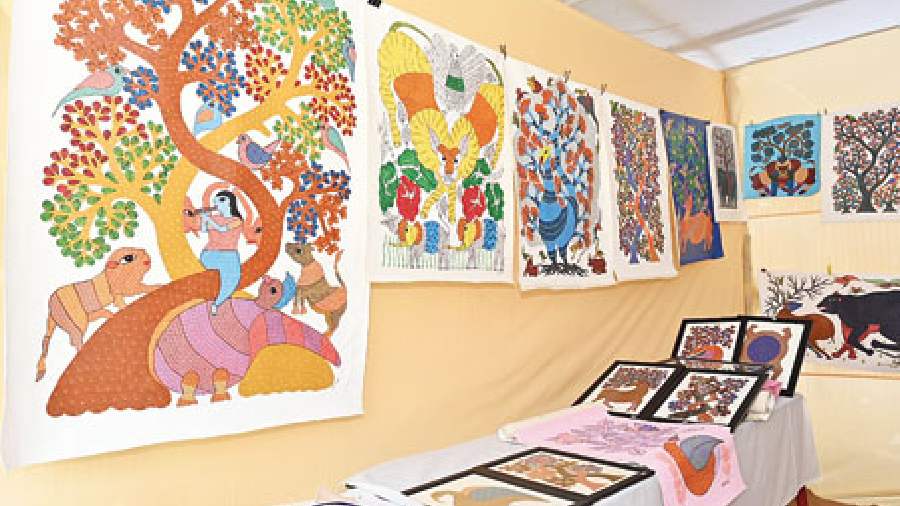
Paintings by Gond tribal artists of Madhya Pradesh on display at one of the numerous handicraft stalls showcasing the art and craftsmanship of tribal men and women
More efficient and economical ways of production were sought to be discovered, with improved quality of products, through experimental methods like using looms of Jharkhand to weave textiles of Maharashtra, and viceversa. Tribal artisans and craftspeople gave a whole new dimension to the confluence of cultures as they shared stories and explored possibilities of crosspollination of art forms, styles and techniques in their creations. Possibilites of taking the help of technology to help artisans on the margins of society were also examined. The cross-culture of indegenous cuisines at the tribal kitchen, especially set up for the five days of Samvaad, resulted in an extraordinary food diversity, fusion styles and opportunities for recipe sharing by tribal home chefs, who prepared a curated tribal lunch comprising recipes from multiple tribes, every day. Apart from this, Samvaad conducted tribal leadership programmes to prepare tribals for political participation, starting at the local level. Those living in poor economic conditions and in remote areas were offered concrete suggestions for financial independence and emancipation like setting up co-operatives.
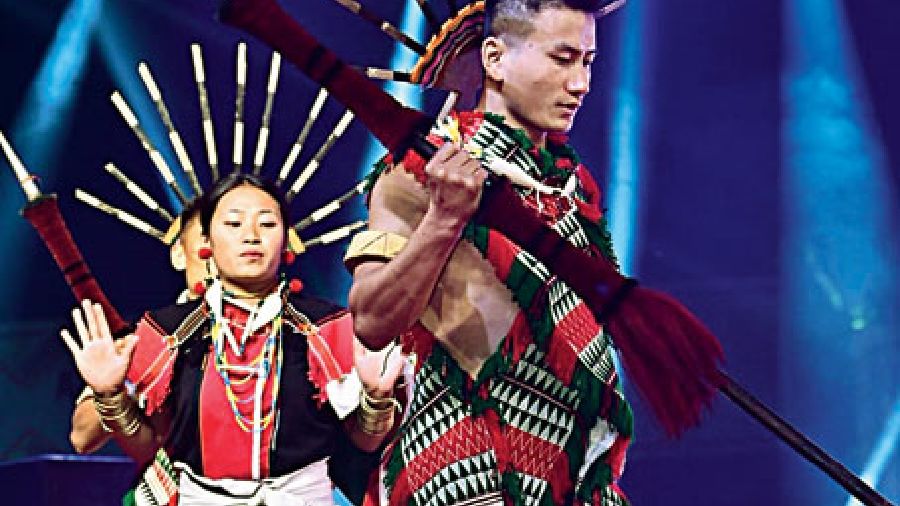
War dance by Maram Nagas
These were just some of the positive outcomes of the meet, the last but not the least being that it provided a platform for unadulterated entertainment through music, song and dance. It brought together tribal talent from the farthest reaches of the country, who presented performances that not only entertained the audience but also represented a true celebration of tribalism at its very best.
